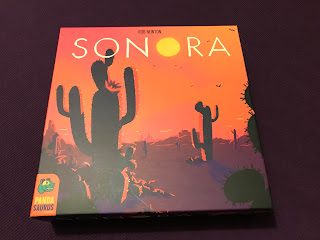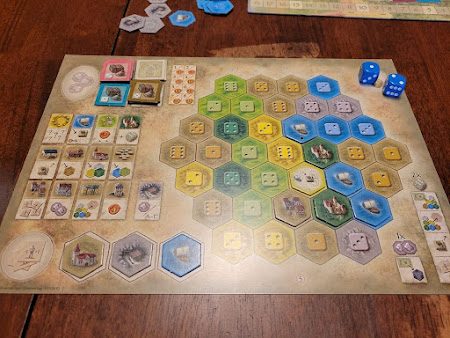Sonora- A Review
A quivering, oppressive sun rests heavily in the arid sky of the Sonora desert, burdening all living things below under the strain of intense heat.
Wait. I'm writing a blog about board games here. But that introduction does reminds me of a game from the great folks at Pandasaurus Games and the mind of Rob Newton- the world's first (presumably) flick-and-write title, Sonora!
How It's Played
Each player selects a color (yellow, purple, green, or blue) and takes the five discs in their chosen color as well as a large laminated play mat and marker. Players will then sit around the square board divided into four quadrants- the owl, the lizard, the rabbit, and the fox and take turns flicking two of their disks. Once everyone has flicked two, the players will take turns flicking two more. Then players will flick their final disk.
Now that everyone has flicked all five of his/her disks, it's time to score. Each quadrant represents a unique mini-game that will be engaged in. How much you get to do in those mini-games depends on the number printed on the disks that reside in each quadrant. The disks are numbered one through five, and players will want to put the higher numbered disks in the quadrants they feel will net them the most points.
The Quadrants
The Lizard- The lizard is the most straight forward. Simply total up the sum of the numbers on disks in this quadrant and choose an area to begin crossing out. There are points for the first and second player to completely cross out an area. First player also gains a bonus.
The Owl- In the owl quadrant, players take the number on a token and count that many spaces from where they last played circling the location where they end up. Players should cross out all spaces that are skipped over while counting. Many times the paths branch out, and it's wise to leave as many divergent options open as possible.
The Fox- The fox is my favorite quadrant! Players take the number on each token and get to draw a connected Tetris-like shape in an attempt to trap various types of succulents and other bonuses. Each number gives players a different shape to draw, but players can always choose to draw a lesser-valued shape.
The Rabbit- In the rabbit area, players add up the total value of the disks in that quadrant of the board and spend anywhere from two to seven of those points to mark off numbered circles. Once a player has marked off two neighboring circles, they are connected. Players will be attempting to connect as many of these circles as possible to ensnare various icons and bonuses for points.
Visuals
I wasn't a huge fan of the artwork in this game, but it's growing on me. Sort of. The animals are an interesting interpretation, and I still see a falcon or hawk most of the time when I glance at the owl. Also, the bonus icons sometimes look like dandelion puffs to me. Not huge deals, but they exist.
Still, I love the use of orange and purple in the game. It perfectly balances the intensity of a desert sunrise with its sharp oranges and vibrant yellows and melts into a twilight of rich purples and blues.
Components
There isn't much to Sonora: five wooden disks, four large laminate play mats, four dry-erase markers, a start player token, and the game board. But that's all this game needs to give its players a unique experience. The disks and the player mats are the high point in Sonora. The dry-erase markers are standard- nothing over the top- passable. I don't care for start player tokens and personally don't use them.
The board is plastic and cardboard and tilts ever so slightly. It lays flat enough on the table, but the cardboard top might need just a little coaxing to find perfection. Play isn't affected, as far as I can tell, but it does drop Sonora's rating a bit over all. I get why Pandasaurus chose the materials they did to create the board- it provides a wonderful Crokinole experience at a fraction of the cost.
The play board resting in the box. This is probably how
you are supposed to play the game, but I like to have it
on the table.
When I look over what I just said about the components, I feel like my opinion might seem worse than it actually is. Overall, I'd say that the components are good. Not great, but although it might lack in over-production quality, the gameplay doesn't detract from it.
Complexity
According to the weight scale on BGG, Sonora measures a 2.38 (as of the time I'm typing this). That's fairly hefty for a typical roll and write. The complexity doesn't come from difficult to understand rules (although I do recommend reading the updated rule book for clarity), but from the four unique mini-games each with their own way of attaining points. These four ways to score might be easy to teach in isolation, but it can be a lot for new players to digest in an up-front rules explanation.
That being said, I feel like a 2.38 (on a scale of 1-5) is fairly accurate. There are a lot of rules, but they aren't beyond even a novice gamer understanding once he/she goes through the rulebook a time or two.
Strategy
There is a strategy in where to aim your numbered tokens and in which quadrants to focus on. However, even the most well-placed token, the one that you desperately needed on a bonus area, can be bumped in the chaos of the traveling tokens. That token of yours resting on a juicy bonus can even be hit deliberately by a player who wants to prevent you from achieving a certain goal.
Several bonus areas that multiply the number on your token make for tempting targets, but if you aim for and hit one of those areas early in the round, the chances are slim that it will remain there at the end of the round. If you need a five disk in a certain area, you can always try to get your token to lay right in the middle, pick it up, and choose where you want it to go. And you can't forget about gaining bonuses while performing the actions of the mini-games. A well timed move on your play mat might result in points, but also in additional actions in other quadrants.
In short, Sonora offers plenty of strategy in where you want your tokens to land. But it also gives its players opportunities for redemption in the plethora of available bonuses for those who flicked for glory, but didn't quite make it.
Fun
This is where I might tip my evaluative hand here a little bit, but this game is so much fun! I've rarely played it against competition, but find myself regularly going at it alone and trying to rack up the highest score possible. Oftentimes my two year old daughter decides to join me and loves to mark up her play mat and flick the disks across the board. She is cute, if not competent competition.
I do have favorites when it comes to the different mini-games, but all of them are unique. Add the first half of each round- the flicking part, and players essentially get to be involved in five games in one, and each one is enjoyable. It is definitely one of my solo go-tos.
Verdict
Sonora is a game with an appropriately desert art style comprised of components that suffice. The game board is tight, filled with glorious victories, but also bonuses to wash away the feelings of gut-wrenching defeats. There are moments of sheer delight seasoned with some of pure luck. And that's ok. It's a quick, delightful game if you want to play solo, and it offers chaotic strategy for two-to-four players.
Recommended!
3.5/5











I've had that on my radar for a while. Looks interesting. Thanks for another great review!!
ReplyDelete